The teeth are one of the most impressive parts of the rat’s body. They grow all throughout their life and are incredibly strong and durable. I’m sure you’re aware that rats can chew through almost anything. However, while most people know a thing or two about rats and their teeth, there are also a lot of unknowns. For instance, many people wonder why rat teeth are yellow or why exactly they keep growing them all throughout their life and as a result, have to grind them down constantly.
In today’s post, we’re going to take a look at 7 very interesting facts about rat teeth. I will discuss everything you’ve ever wanted to know (and probably more!) about these rodents and their extremely durable fangs. Let’s dig in.
Rat teeth 101: A brief overview
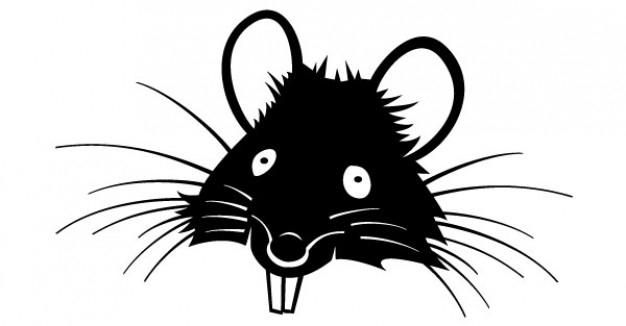
Rats have two different types of teeth: incisors and molars. The incisors are the long and sharp fangs in the front of their mouth. They have 2 of these on the top and 2 on the bottom of their mouth. Rats use their incisors to gnaw and tear through things. In addition, rats also have molars. The molars are located in the back of their mouth and are used to grind down food so that they can swallow it.
Rats have a total of 16 teeth – 4 incisors and 12 molars. They do not have premolars or canines. Their dental formula is 2 x (1 1/1, C 0/0, P 0/0, M 3/3)
As you might know, rats have teeth that grow throughout their life. However, it’s a misconception that all their teeth continuously grow. Only the 4 incisors grow throughout their life, the molars do not continue to grow once they’re fully developed.
In addition, rats have only 1 set of teeth – this is called being monophyodont. They do not have baby teeth like we humans do that get replaced with adult teeth. Because of that, rats also do not go through the teething process.
Now that the basics are out of the way, let’s get into the facts!
1. Rat teeth never stop growing
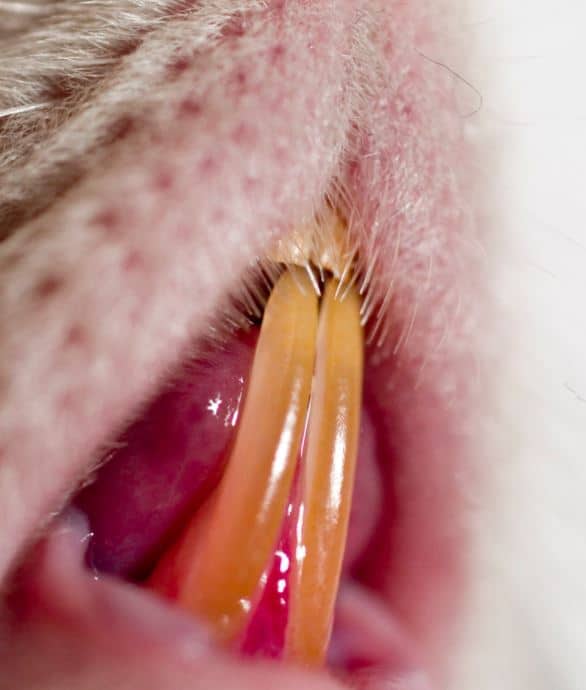
The 4 incisors in the rat’s mouth keep growing throughout their life and as a result, they have to grind them down continuously to prevent them from growing too long, but why is that? If they have to keep grinding them down, what’s the point of growing them back all the time?
The reason why their incisors never stop growing is that rats chew through a lot of hard stuff. They have to chew through nuts and other hard edibles. Because of this, their incisors wear down. If their incisors stopped growing they would eventually end up with little more than stumps for teeth. With these stumps, they would not be able to eat the foods they need and as a result, they would die of a lack of food.
So, it’s not really the case that rats grind down their teeth because they keep growing, but rather the opposite: the rat’s teeth never stop growing because they keep grinding them down in nature as a result of their diet.
In captivity, this is a little bit different. Pet rats have a very different diet from wild rats. They use their teeth to a much lesser extent and as a result, they wear down much less. Therefore, they need access to chew toys to grind down their incisors to prevent them from getting too long.
2. Rats naturally have yellow teeth
We humans usually see pearly white dentition as a sign of them being in good shape. For rats, this is different. Yellow fangs don’t mean that they’re dirty or that there’s something wrong with them. In fact, the yellow color is perfectly normal and healthy. The reason why their teeth are so yellow is that they have an iron-containing pigment in them which gives them their yellow color, so it has nothing to do with dirt or staining!
Interestingly enough, newborn rats do have white teeth. Their fangs only start turning yellow at around 21 days after birth and by 38 days after birth, they’ve reached their full, iconic, yellow color. However, as I’ve said, this is not because they become dirty, but rather because the pigment hasn’t fully developed yet until then.
3. Only their 4 incisors are visible
When you look at a rat’s mouth you often only see its 4 incisors and not the molars. The incisors are the largest and are most prominently placed in their mouth. The molars are further back so you barely ever see those. I can describe the way their teeth look, but a picture says more than a thousand words. Take a look at the image below:
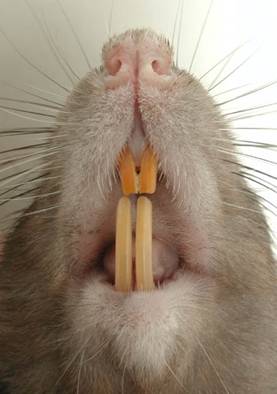
As you can see in the photo, you can only see the incisors. To get an idea of what their molars look like it’s best to look at a skeleton:
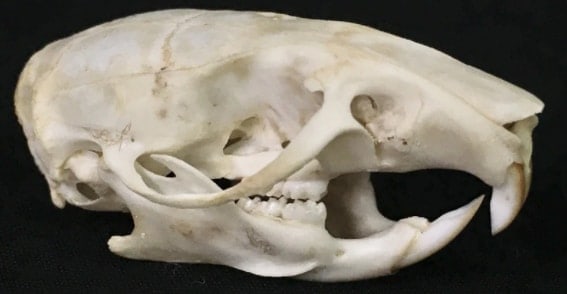
As you can see in this diagram, the molars are much further back than their incisors which explains why they’re so hard to see in a live rat.
4. Rats need to grind down their teeth continuously
Rats grind down their teeth because they never stop growing. Their incisors grow at a very fast rate. The upper incisors grow at a rate of ~0.3 mm per day, while the lower ones grow at a rate of ~0.4 mm a day. Interestingly enough, their incisors can grow back even faster than that if they grind them down more or if they’re clipped off.
Since their incisors grow so much they need to grind them down. If they do not grind them down they can grow so long that they interfere with eating. Also, they grind them down to keep them sharp enough to bite through foods and objects.
Rats can grind their chompers down on hard foods or on chew toys. In addition, they grind their teeth down on one another – this is called bruxing. They often exhibit this behavior when they’re in a relaxed state.
5. In some cases it’s necessary to clip your rat’s teeth
Rats in the wild grind down their incisors enough through their food and environment that they do not need to be trimmed. However, captive pet rats tend to grind them down much less on their food. Chew toys can help with this, and usually, you do not need to clip your rat’s teeth.
Nevertheless, sometimes due to malalignment they can not grind their teeth down properly. This results in their incisors growing too long and then they do need to be clipped.
If your rat’s incisors look something like this:
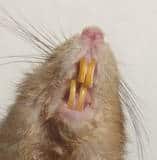
They will not be able to grind them down properly and they will need to be clipped. You can do this yourself or you can let a vet do it. If you’re inexperienced I definitely would recommend letting a vet do it, at least the first time. If you want to learn how to do it yourself, you can come along so he can give you some pointers so that you can do it at home next time.
How to trim rat teeth at home
Rats do not have nerve endings in the ends of their incisors so you do not have to worry that clipping them will hurt your rat. However, while it is necessary to clip their teeth if they have malocclusion, they will not enjoy it and will most likely resist. It’s best if you tackle this problem in a team of 2: 1 person to hold the rat, the other to clip the incisors.
The best tool to clip the incisors are bird toenail scissors (I recommend these). The top incisors should be clipped to a length of around a quarter inch, while the bottom incisors should be around half an inch in length.
6. You do not need to brush your rat’s teeth
Rats are pretty clean and smart animals, but they have not (yet) figured out how to brush their teeth. Luckily for them, they do not have to. They’re very capable of good detail hygiene even without brushing. Because of that, they remain quite clean on their own so there’s really no need to use a toothbrush Keep in mind, just because your rat has yellow teeth does not mean that they’re dirty – this is their natural color and does not mean that they need to be cleaned.
However, while you do not need to clean their teeth, that doesn’t mean that rats can not have tooth decay or cavities. You should take preventative measures to prevent tooth decay.
Make sure that you do not feed your rat foods that are too high in sugar. Just like in humans, sugar is bad for your rat’s teeth because the bacteria in their mouth feed on it and leave waste products behind which can erode the enamel.
7. Rat teeth are incredibly hard
Rat teeth are incredibly hard because they have very strong enamel. There’s a scale to measure the hardness of minerals called Moh’s Scale. On this scale, which ranges from 1 to 10, with diamonds being a 10, rat’s enamel scores a 5.5 while human enamel scores a 5.
This means that rat teeth are harder than iron, copper, and even platinum. Because of their hard enamel, rats are able to chew through many materials such as cinder blocks, wood, plastic, and aluminum sheeting.
- How Long Do American Eskimo Dogs Live? Important Factors and Care Tips - September 29, 2023
- Do American Bulldogs Need Grooming? Essential Tips and Care Guidelines - September 29, 2023
- Do Bengal Cats Enjoy Playing? Essential Tips for Keeping Them Active - September 29, 2023